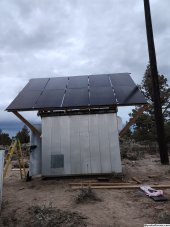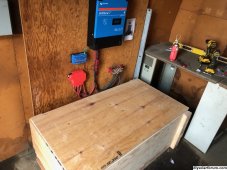chriscappuccio
New Member
- Joined
- Apr 29, 2022
- Messages
- 78
Here's a desert comms site. It's a 48v-only site, no AC so there is less overall conversion waste.
The site has 10 Canadian Solar 400W CS6R-400MS-HL, two strings in 5 series each.
Each string plugs into its own MPPT charger on one Victron MPPT RS 450/100-Tr.
The site is using LiTime 51.2V 100Ah batteries in parallel to the Victron. The positive leads are fused with AMG fuses using an LMG fuse holder including the Victron itself. https://www.eaton.com/us/en-us/catalog/emobility/series-lmg.html The LMG "common input" will be used to connect the LMG's positive bus bar to a 48v telecom fuse panel.
It gets into the teens in the winter, and occasionally even negative temps. I'm still thinking about some heating pads for the batteries since there is no heated 48v option. I'm thinking one 400w panel wired direct to several pads in series/parallel with temp control relays but I haven't settled on anything yet.
The goal here is to power around 250w-350w load continuously, forever. On some really cloudy weeks we may have to plug in a generator. Hopefully this is rare, and the multitude of panels provides enough charging during short periods of sun during the fall or winter that the site can survive with only rare use of a generator.



The site has 10 Canadian Solar 400W CS6R-400MS-HL, two strings in 5 series each.
Each string plugs into its own MPPT charger on one Victron MPPT RS 450/100-Tr.
The site is using LiTime 51.2V 100Ah batteries in parallel to the Victron. The positive leads are fused with AMG fuses using an LMG fuse holder including the Victron itself. https://www.eaton.com/us/en-us/catalog/emobility/series-lmg.html The LMG "common input" will be used to connect the LMG's positive bus bar to a 48v telecom fuse panel.
It gets into the teens in the winter, and occasionally even negative temps. I'm still thinking about some heating pads for the batteries since there is no heated 48v option. I'm thinking one 400w panel wired direct to several pads in series/parallel with temp control relays but I haven't settled on anything yet.
The goal here is to power around 250w-350w load continuously, forever. On some really cloudy weeks we may have to plug in a generator. Hopefully this is rare, and the multitude of panels provides enough charging during short periods of sun during the fall or winter that the site can survive with only rare use of a generator.




Last edited:



